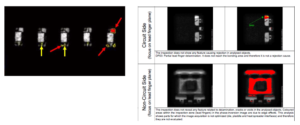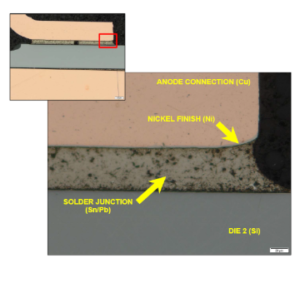TAS’ Experience with AEC Devices in Launcher Applications
- Posted by Luis de Pablo Martinez
- On December 3, 2019
- 0
Agenda
- INTRODUCTION: WHY AEC FOR LAUNCHERS
- SOME FIGURES FROM ARIANE-6: 70% AEC
- SUPPLIERS. THE KEY DECISION. TRACEABILITY & COUNTERFEIT
- CONTROL OF PCN/PDN. OBSOLESCENCE & LAST TIME BUY
- AEC-Q MANUFACTURERS FEEDBACK: FROM THE VERY BAD TO THE VERY GOOD
- INCOMING OF AEC-Q DEVICES (100% VISUAL &XRF): NO FAILURES
- CONSTRUCTIONAL ANALYSIS: DELAMINATIONS
- ROHS & REACH: INTERNAL PB SOLDERINGS
- CONCLUSIONS
INTRODUCTION: WHY AEC FOR LAUNCHERS
- ARIANE-6: A6-GR-1000000-X-32-ASL Issue 1 EEE Components & Assembly technologies policy
- Ariane-5 Large Heritage with AEC-Q devices. Field Return: No failures
- AEC-Q devices meet A6 requirements on Components Reliability Data
- AEC-Q devices meet A6 requirements on whisker data
- No Total Ionisation Dose (TID) / Total Non Ionisation Dose (TNID) requirements for launchers but Single Event Effect: avoid non recoverable effects a LETth<35MeV*cm2/mg
- AEC-Q devices: Constructional Analysis as per ECSS-Q-ST-60-13C, and heavy ions testing as applicable
- RoHS & REACH required
- This policy is in line ECSS-Q-ST-60-13c Grade-3 except by ROHS & REACH and lack of TID/NITD
- EEE Components meeting Araine-6 requirements are classified in TAS Parts Common data Base as Grade-4 to segregate with other Grade-1/Grade-2/Grade-3 COTS as per ECSS-Q-ST-60-13C
- VEGA-C : VG-SG-1-D-0032-SYS Iss.2 Rev.1 VEGA-C Launcher Vehicle EEE components’s policy
- Similar approach as Ariane-6 for the “Industrial procedure”.
SOME FIGURES FROM ARIANE-6: 70% AEC
- TAS in Belgium Analysis :
- 4 Equipments: 596 line items (374 passives, 109 connectors, 113 actives). 407 are automotive ; 169 pure commercial ; 14 are PEDs (Plastic Enhanced Devices with Vendor Item Drawing); 6 are HiREL
- TASiB. 93 Justification documents prepared.
- TASinSpain:
- 1 Single Equipment: 96 line items (including passive values), 73 types where 43 are AEC-Q, 7 are PEDs (with VID), 22 are pure commercial, and 1 is 883B.
- 54 Justification Documents prepared by TASiS, 13 reused from those prepared by TASiB.
- Total:
- 67% components are AEC-Q. 70% including AEC+PED.
SUPPLIERS. THE KEY DECISION. TRACEABILITY & COUNTERFEIT
- Define 2 or 3 preferred and authorized distributors (DIGI-KEY; MOUSER, FARNELL, ARROW, AVNET…)
- Provide the complete list to distributor for PCN/PDN tracking
- Clarify the needs to distributors:
- Traceability (Lot Date Code; assembly Lot, wafer Lot)
- 1-year old Lots
- Single Lot, Lot homogeneity
- Appropriate packaging
- Cannot accept non AEC-Q alternatives, different manufacturer alternative
- Counterfeit Controls(Visual, Fischerscope, Constructional Analysis / DPA…)
- Problems with suppliers:
- Lead Times Very problematic for resistors and capacitors due to worldwide shortage. 2 or 3 sources recommended
- Difficulties with requirement on single lot, tracebility, etc.. For some distributors
- Very big minimum buys for some non preferred distributors
- Export License for PEDs and some high end AEC (ECCN 3A001a.2.c; 5A991b; 3A991b.1a, etc..)
CONTROL OF PCN/PDN. OBSOLESCENCE & LAST TIME BUY
- Follow-up of PCN/PDN imply a very huge amount of work. Recommended to be centralised by a single company.
- Follow-up of PCN is critical, along with Constructional Analysis and Incoming, for:
- Changes affecting radiation (die: mask number, diffusion site, second sources)
- Changes affecting mounting qualification (assembly construction techniques, materials, assembly site, second sources for materials or assembly)
- Reliability data
- Obsolescence, Last Time Buy
- Export Licernse
- Countrefeit Controls
- Obsolescence / Last Time Buy :
- Although product life cycle of AEC-Q products are expected to be much longer than thiose of pure commercial, TASiS experienced 3 LTB in 2 years (2 of them AEC-Q) for `products with End of Life not expected before 2023.
AEC-Q MANUFACTURERS FEEDBACK: FROM THE VERY BAD TO THE VERY GOOD
- Very big differences in the feedback and support from AEC-Q manufacturers
- from the VERY BAD: almost no answer, impossible to get reliability data, PPAP (Production Parts Approval Process), info on ESD, support from Constructional Analysis findings, etc..
- To the VERY GOOD: willing to provide reliability reports PPAP, support for application and failures, etc…
- Recommended :
- Establish early communication channel with manufacturers
- Work preferably with manufacturers with better support
INCOMING OF AEC-Q DEVICES (VISUAL & XRF): NO FAILURES
- 1st LOT INCOMING :
- Visual Inspection: should follow JESD22-B101C (best standard, ESCC or MIL standard are not appropriate)
- Fischerscope Inspection on 2 pieces 2 points whatever finish (pure tin, SAC, ENEPIG, etc…):
No anomalies seen on AEC-Q devices but on commercial , custom magnetic, etc.
Findings were most cosmetic and in a fraction of per cent of devices: small chip-out, lead frame copper exposed, marks on terminations, etc..
CONSTRUCTIONAL ANALYSIS: DELAMINATIONS
- Around 200 CA/DPA done. More than 100 on AEC-Q devices. Some more in progress
- Constructional Analysis follows ECSS-Q-ST-60-13C for semiconductors and own TYAS standard for passive. For commercial metal-ceramic cavity RF devices (non hermetic, adhesive sealing) CA as for hirel hermetic excepting RGA
- No anomalies found on AEC-Q devices excepted delaminactions seen in C-SAM inspection
- Delamination observed on at least 5 constructional analysis (2 of them were AEC-Q).
- All were classified as minor: very small size confirmed by micro-sections and very good bond pull results when delamination are located under bonding pads
- Manufacturer feedback: considered them as cosmetic as not affecting AEC reliability testing
- Manufactyurer feedback: follow J-STD-020E instruction to check for delamination evolution if any:
- Initial Electricals+Visual+C-SAM
- Conditioning (thermal cycling, bake, reflow)
- Final Initial Electricals+Visual+C-SAM, plus measurement of crack/void growth if any.
-
- In progress at TASiS
- Manufacturer feedback: could have less delamination for halogen free package version
CONSTRUCTIONAL ANALYSIS: DELAMINATIONS (CONT’D)

 ROHS & REACH: INTERNAL PB SOLDERING
ROHS & REACH: INTERNAL PB SOLDERING
- Observation in CA : Internal Pb95Sn5 soldering not declared in data sheet (which states RoHs & REACH compliance) found in many diodes (5) y in transistors (2) in packages as D2PACK.
- It is allowed by exception 7a of Article 4(1) of RoHS Directive 2002/95/EC mainly for:
- 5. Lead in glass of cathode ray tubes, electronic components and fluorescent tubes.
- 7a. – Lead in high melting temperature type solders (i.e. tin-lead solder alloys containing
- more than 85 % lead),
- 7d – lead in electronic ceramic parts (e.g. piezoelectronic devices).
CONCLUSIONS
- No major anomaly found on AEC-Q devices during constructional Analysis (except minor delaminations, or non RoHs internal Pb soldering) or during Incoming.
- Constructional Analysis on each lot has a high added value (lot to lot variability tracking, Counterfeit, PCN, RoHs). Incoming Visual has low added value on 2nd lot.
- Get complete Lot Traceability, single lot, less than 1-year lots could be difficult: work only with preferred distributors.
- Follow-up of PCN/PDN is critical.
- Increase attrition policy. Inert storage recommended.
Latest posts by Luis de Pablo Martinez (see all)
- TAS’ Experience with AEC Devices in Launcher Applications - December 3, 2019
- Assessment of automotive EEE Components Suitability for Space applications - November 27, 2019


0 comments on TAS’ Experience with AEC Devices in Launcher Applications